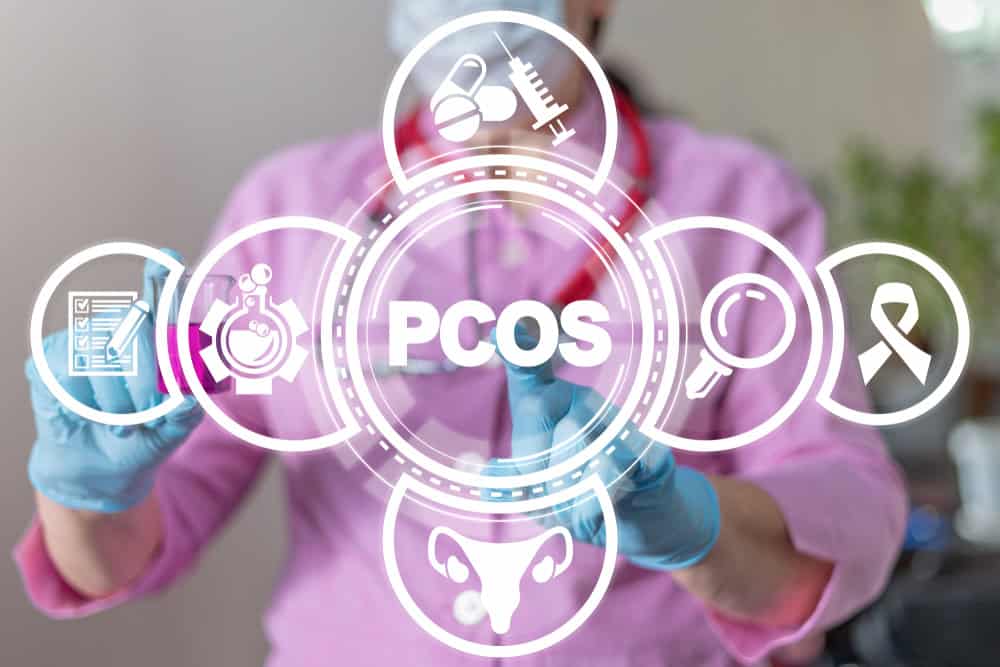The gut microbiota, a constituent part of the human microbiome, plays a key role in regulating digestion, immunity, and metabolic balance1-4. Disruption of microbiota balance (dysbiosis) has been linked to chronic diseases, and increasing evidence suggests it is also involved in the pathogenesis of PCOS5. In patients with PCOS, reduced microbial diversity, altered microbiota composition, and lower levels of beneficial metabolites are frequently observed, which may exacerbate inflammation, insulin resistance, and hormonal imbalance6-10. Given that disturbances in gonadotropin secretion, insulin resistance, and metabolic dysregulation are key mechanisms of PCOS, the microbiome is gaining recognition as a potential therapeutic target11.
Gut microbiome in women with PCOS
Current research indicates significant differences in the composition and metabolic activity of the gut microbiome between women with polycystic ovary syndrome (PCOS) and healthy controls. These differences are primarily evident in certain aspects of microbial diversity, the presence of specific bacterial genera, and functional patterns of microbial metabolism12.
Reduced diversity
Numerous studies have shown that women with polycystic ovary syndrome (PCOS) exhibit significantly reduced microbial alpha diversity compared to healthy control groups7,13-15. For example, Torres et al. found that alpha diversity of the gut microbiome in women with PCOS was significantly reduced, and this reduction negatively correlated with hyperandrogenemia, total testosterone concentrations, and the presence of hirsutism. Similar findings were reported by Insenser et al., who, in addition to the general decrease in diversity, noted specific changes in the composition of the gut microbiome in women with PCOS, including an increased presence of the bacterial groups Actinobacteria and Candidatus. Such a reduction in microbial diversity suggests decreased stability and resilience of the gut microecological community, thereby increasing the host’s vulnerability to external factors and further disrupting the existing metabolic and immune balance6,17.
Bacteroidetes / Firmicutes ratio
The two predominant bacterial phyla in the human gut microbiome, Bacteroidetes and Firmicutes, play a key role in maintaining metabolic homeostasis, and disturbances in their relative abundance have frequently been associated with various metabolic disorders18,19. Lindheim et al. analyzed fecal samples from 24 women diagnosed with PCOS, divided into obese and non-obese groups, and compared them with samples from 19 healthy controls. The results showed that women with PCOS had a significantly increased relative abundance of Bacteroidetes, while the proportion of Firmicutes was decreased, resulting in a more pronounced imbalance between these two dominant bacterial groups20. In line with this, Liu et al. reached similar conclusions in a study involving 33 PCOS patients and 15 healthy controls. An excessive abundance of Bacteroidetes may be interpreted as an indicator of gut dysbiosis in the PCOS population, and such microbial imbalance could potentially contribute to the development of metabolic disorders and impairment of the host’s immune function21.
Abundance of specific bacteria
Studies have indicated significant changes in the abundance of certain bacterial genera in the gut microbiome of women with PCOS compared to healthy individuals22,23. In the study by Qi et al., metagenomic sequencing of fecal samples from 50 PCOS patients and 43 healthy controls revealed a significant decrease in beneficial bacteria such as Akkermansia and Bifidobacterium in the PCOS group3. At the same time, an increase in Desulfovibrio bacteria, known to be associated with metabolic dysfunction and proinflammatory processes, was observed. Insenser et al. additionally reported a reduction in the abundance of the genus Prevotella among women with PCOS. These changes in microbiota composition suggest a loss of beneficial microorganisms and an increase in potentially harmful bacterial populations, thereby disrupting gut microbial balance and potentially exacerbating the metabolic and immune aspects of PCOS17.
Changes in the composition of firmicutes
The Firmicutes phylum includes numerous bacterial genera such as Lactobacillus, Clostridium, and Ruminococcus, and is considered one of the key components of the gut microbiome24. In addition to the overall reduction in the abundance of this phylum in women with PCOS, alterations in its intra-group structure have also been observed. For instance, Liu et al. reported an increased abundance of the genera Ruminococcus and Coprococcus within the Firmicutes phylum in PCOS patients. This finding stands in stark contrast to the microbial structure observed in healthy controls, suggesting that disturbances in specific bacterial populations may be associated with the metabolic imbalance characteristic of PCOS.
According to the authors, the increased presence of these genera may play an important role in the pathogenesis of the syndrome, acting through modulation of short-chain fatty acid metabolism and activation of proinflammatory signaling pathways21. The data from Liu’s team are supported by the findings of Zeng et al., who also identified elevated levels of Ruminococcus and Coprococcus in women with PCOS. Such proliferation of specific bacterial groups further confirms the disrupted internal balance within the Firmicutes phylum and reflects a distinct pattern of metabolic dysregulation in the microbiota of individuals with this syndrome25.
Changes in metabolite levels
An increasing body of evidence suggests that women with polycystic ovary syndrome (PCOS) exhibit an altered metabolic profile of the gut microbiota26. In this context, Zeng et al. reported significantly lower concentrations of short-chain fatty acids, particularly butyrate, in stool samples from women with PCOS compared to healthy controls25. Furthermore, Qi et al. applied a combined metagenomic and metabolomic approach, observing an enrichment of gene sequences involved in amino acid metabolism within the microbiota of PCOS patients, along with elevated plasma concentrations of branched-chain amino acids (BCAAs)6. Given that metabolic complications such as obesity, hyperglycemia, and dyslipidemia are common in this population, it is not surprising that several studies have confirmed a positive correlation between circulating BCAA levels and markers of metabolic syndrome, including body weight, body mass index (BMI), and the degree of insulin resistance27,28. These changes in metabolites further illustrate impaired functional activity of the gut microbiota and may play a role in the development and progression of PCOS.
Gut microbiota dysbiosis and metabolic disorders in PCOS
Metabolic homeostasis in patients with PCOS is influenced by gut microbiota dysbiosis. Various mechanisms may potentially contribute to the development of metabolic conditions such as insulin resistance, impaired glucose metabolism, and lipid metabolism disorders12.
Glucose metabolism
In patients with polycystic ovary syndrome (PCOS), an increased ratio of the bacterial phyla Bacteroidetes to Firmicutes is frequently reported. This imbalance is often associated with the onset of obesity and the development of insulin resistance29. Within the Bacteroidetes phylum, certain genera such as Prevotella exhibit a pronounced capacity for carbohydrate fermentation, thereby promoting the production of short-chain fatty acids (SCFAs), which play a key role in regulating the host’s energy homeostasis30. However, reduced concentrations of SCFAs have been observed in the gut environment of women with PCOS, potentially diminishing their beneficial metabolic effects.
Lipid metabolism
Gut microbiota dysbiosis in women with PCOS significantly affects lipid metabolism through various mechanisms31. One such mechanism involves alterations in the composition of the Firmicutes phylum, which may lead to reduced production of short-chain fatty acids (SCFAs), particularly butyrate. These fatty acids not only represent an important energy source for enterocytes but also participate in the regulation of lipid metabolism via activation of the G protein-coupled receptor GPR43. Activation of this receptor inhibits lipolysis in adipocytes, thereby reducing the release of free fatty acids, improving insulin sensitivity, and contributing to the maintenance of lipid homeostasis32. Consequently, reduced SCFA levels in the gut may represent one of the factors contributing to lipid metabolism dysfunction in the population of women with PCOS. In addition, a decrease in the abundance of bacterial genera involved in lipid synthesis and processing, such as Prevotella, may further impair the gut’s ability to efficiently metabolize dietary fats33.
Bile acid metabolism
Bile acids, synthesized from cholesterol in the liver, play a key role in emulsifying and absorbing dietary lipids34,35. In addition to their digestive function, recent research suggests that bile acids also possess important endocrine functions, including regulation of glucose and lipid metabolism. The conversion of primary into secondary bile acids is enabled by enzymes present in the gut microbiota, particularly bile salt hydrolases (BSH). Secondary bile acids are more hydrophobic and exhibit stronger signaling effects compared to their primary counterparts36,37. Qi et al demonstrated that in the microbiome of women with PCOS, genes encoding BSH enzymes are more abundant, resulting in increased synthesis of secondary bile acids. This process stimulates the secretion of incretin hormones such as GLP-1 from intestinal L-cells via activation of the TGR5 receptor, which may positively influence insulin secretion and enhance insulin sensitivity in peripheral tissues6.
The gut–brain axis and vagus nerve in the pathogenesis and treatment of PCOS
The pathophysiology of polycystic ovary syndrome (PCOS) is increasingly being examined through the lens of complex neuroimmunoendocrine mechanisms that extend beyond the traditional hypothalamic–pituitary–ovarian axis, encompassing the gut–brain axis as a key regulatory network38. This bidirectional axis enables continuous communication between the central nervous system and the gastrointestinal tract and involves neurological, endocrine, immune, and metabolic components39. The vagus nerve plays a central role as the main functional mediator of this axis38.
The gut microbiota can influence the central nervous system directly via vagus nerve stimulation and indirectly through the synthesis of neurotransmitters and other signaling molecules such as serotonin, GABA, dopamine, and short-chain fatty acids (SCFAs)40. These signals are transmitted back to the brain, modulating emotional states, energy metabolism, and hormonal balance. In the context of PCOS, women commonly exhibit gut microbiota dysbiosis, characterized by a dominance of potentially harmful bacteria and a reduction in beneficial genera. This imbalance disrupts gut barrier function (the so-called “leaky gut”), increases systemic inflammation, and exacerbates insulin resistance38.
Through the cholinergic anti-inflammatory pathway (CAP), the vagus nerve releases acetylcholine, which suppresses pro-inflammatory cytokines such as TNF-α and IL-6, thereby reducing inflammation, improving insulin sensitivity, and regulating energy metabolism and fat storage. Additionally, vagus nerve stimulation can enhance the secretion of GLP-1 and PYY, hormones that further support glycemic control and reduce insulin resistance in PCOS patients. The vagus nerve also influences the regulation of the hypothalamic–pituitary–ovarian (HPO) axis by modulating estrogen and androgen levels, potentially restoring ovulation and improving fertility38.
The neurotransmitter component of the gut–brain axis also plays a significant role in the psychological aspects of PCOS, given the frequent occurrence of depression and anxiety. The vagus nerve affects mood by modulating serotonergic and GABAergic pathways, and vagal dysfunction has been shown to exacerbate mood symptoms in this population. Vagus nerve stimulation (VNS), currently under investigation as a therapeutic method, may enhance vagal activity and consequently modulate neurotransmitters, hormones, and inflammatory mediators, thereby addressing multiple facets of PCOS pathophysiology directly38.
Fecal microbiota transplantation (FMT) and its therapeutic potential in regulating microbiome and metabolic imbalance in PCOS
Studies conducted on animal models of PCOS have demonstrated that the administration of fecal microbiota from healthy control mice leads to a significant reduction in alpha diversity, alongside a shift in beta diversity towards patterns observed in healthy animals41. These findings are consistent with previous research confirming the capacity of FMT to restore gut eubiosis in letrozole-induced PCOS models. In addition to microbial recovery, a reduction in metabolic disturbances and alleviation of ovarian changes characteristic of the syndrome have been reported42,43.
Zhang et al., using a rat model of PCOS, compared short-term FMT administration (three times a week for two weeks) with conventional approaches including probiotic supplementation, oral contraceptive therapy, and berberine treatment. While results indicated partial improvement in metabolic parameters and microbial diversity regulation, short-term FMT was less effective compared to prolonged probiotic treatments. This suggests that optimal therapeutic effects of FMT may require extended application or integration into combination therapeutic protocols44.
Despite its potential benefits, FMT carries certain risks. Even with rigorous donor screening protocols, there remains a possibility of transmitting pathogenic microorganisms, including bacteria, viruses, fungi, and parasites45. Additionally, the recipient’s immune system may react to the transplanted microbiota, which in some cases could provoke chronic inflammation or exacerbate existing autoimmune conditions46. Furthermore, FMT may alter immune regulation and influence the existing state of low-grade chronic inflammation, which is characteristic of women with PCOS47.
The impact of diet on PCOS
Dietary patterns – particularly the source of protein – have a significant impact on the composition of the gut microbiota. Diets rich in animal proteins have been shown to promote the growth of bacteria such as Bacteroides, Alistipes, and certain Bifidobacterium species, while simultaneously reducing the overall abundance of Bifidobacterium in adolescents. In contrast, increased intake of plant-based proteins is associated with a more favorable microbial profile, including a rise in beneficial genera such as Bifidobacterium and Lactobacillus, a reduction in potentially pathogenic bacteria from genera such as Bacteroides and Clostridium perfringens, and enhanced production of short-chain fatty acids (SCFAs)48,49.
Reducing the intake of animal proteins in combination with increased levels of aerobic physical activity has been shown to effectively lower concentrations of branched-chain amino acids (BCAAs) and enhance SCFA production, which may contribute to improved glycemic control and increased insulin sensitivity in women with PCOS12.
Use of probiotics and prebiotics
Although Lactobacillus and Bifidobacterium genera have been shown to partially alleviate clinical manifestations of PCOS and positively affect certain metabolic parameters, their overall effectiveness remains limited in most cases50. In contrast, prebiotic intake has been proven to stimulate the proliferation of bifidobacteria in the colon and to promote the secretion of glucagon-like peptide-1 (GLP-1) from colonic L-cells, thereby contributing to improved insulin sensitivity51.
Moreover, certain members of the gut microbiota are capable of synthesizing and releasing gamma-aminobutyric acid (GABA), a neurotransmitter with additional metabolic functions52. Some strains of Lactobacillus and Bifidobacterium have demonstrated the ability to produce GABA, providing a theoretical basis for their role in modulating the GABAergic system via the gut-brain axis53-55.
Zhang and colleagues found that Bifidobacterium lactis V9 increases the abundance of SCFA-producing bacteria (Akkermansia, Butyricimonas, and Faecalibacterium prausnitzii) by influencing gut-brain mediators, resulting in a reduction of the LH/FSH ratio in women with PCOS. Notably, Akkermansia showed the ability to restore eubiosis in humans. These findings suggest that probiotics may serve as an adjunct therapy for the treatment of PCOS48.

Conclusion
The gut microbiota is increasingly recognized as an important factor in the pathophysiology of polycystic ovary syndrome (PCOS), a disorder marked by pronounced clinical and metabolic heterogeneity. Current research consistently indicates the presence of gut dysbiosis in women with PCOS, characterized by reduced microbial diversity, disruption in the balance of key bacterial groups, and alterations in microbial metabolic activity. These changes are associated with numerous adverse host effects, including low-grade chronic inflammation, insulin resistance, dysregulation of glucose and lipid metabolism, and bile acid signaling dysfunction.
Given these insights, the gut microbiota is increasingly considered a potential biomarker for identifying disease subtypes and predicting therapeutic response, thus paving the way for more personalized treatment approaches. Interventions aimed at modulating gut microbiota composition – such as the use of probiotics and prebiotics, fecal microbiota transplantation (FMT), and dietary modification – show promising therapeutic potential for alleviating metabolic disturbances and clinical symptoms of PCOS. Nevertheless, despite the growing body of evidence, our understanding of the interactions between the microbiota and PCOS remains limited. Further research – methodologically standardized and longitudinal in design – is needed to clarify causal relationships and to develop more targeted microbiota-based therapeutic strategies.
References:
(1) Shanahan F, Ghosh TS, O’Toole PW (2021). The healthy microbiome-what is the definition of a healthy gut microbiome? Gastroenterology. 160:483–94.
(2) Milani C, Duranti S, Bottacini F, Casey E, Turroni F (2017). The first microbial colonizers of the human gut: composition, activities, and health implications of the infant gut microbiota. Microbiol Mol Biol Rev. 81:e00036–17. doi:
(3) Munyaka PM, Khafipour E, Ghia JE (2014). External influence of early childhood establishment of gut microbiota and subsequent health implications. Front Pediatr. 2:109.
(4) Lynch SV, Pedersen O (2016). The human intestinal microbiome in health and disease. N Engl J Med. 375:2369–79.
(5) He Y, Wang Q, Li X, Wang G, Zhao J, Zhang H, et al. (2020). Lactic acid bacteria alleviate polycystic ovarian syndrome by regulating sex hormone related gut microbiota. Food Funct. 11:5192–204.
(6) Qi X, Yun C, Sun L, Xia J, Wu Q, Wang Y, et al. (2019). Gut microbiota-bile acid-interleukin-22 axis orchestrates polycystic ovary syndrome. Nat Med. 25:1225–33.
(7) Li P, Shuai P, Shen S, Zheng H, Sun P, Zhang R, et al. (2023). Perturbations in gut microbiota composition in patients with polycystic ovary syndrome: a systematic review and meta-analysis. BMC Med. 21:302.
(8) Corrie L, Gulati M, Vishwas S, Kapoor B, Singh S, Awasthi A, et al. (2021). Combination therapy of curcumin and fecal microbiota transplant: potential treatment of polycystic ovarian syndrome. Med Hypotheses. 154:110644.
(9) Tremellen K, Pearce K (2012). Dysbiosis of gut microbiota (DOGMA) – a novel theory for the development of polycystic ovarian syndrome. Med Hypotheses. 79:104–12.
(10) Xu Y, Wang N, Tan HY, Li S, Zhang C, Feng Y (2020). Function of Akkermansia muciniphila in obesity: interactions with lipid metabolism, immune response and gut systems. Front Microbiol. 11:219.
(11) Szczuko M, Kikut J, Szczuko U, Szydłowska I, Nawrocka-Rutkowska J, Ziętek M, Verbanac D, Saso L (2021). Nutrition Strategy and Life Style in Polycystic Ovary Syndrome-Narrative Review. Nutrients. 13(7):2452.
(12) Li C, Cheng D, Ren H, Zhang T (2025) . Unraveling the gut microbiota’s role in PCOS: a new frontier in metabolic health. Front Endocrinol (Lausanne). 16:1529703.
(13) Thackray VG (2019). Sex, microbes, and polycystic ovary syndrome. Trends Endocrinol Metab. 30:54–65.
(14) He F, Li Y (2021). The gut microbial composition in polycystic ovary syndrome with insulin resistance: from a normal-weight population. J Ovarian Res. 14:50.
(15) Zhu, Zhang N (2024). Gut microbiome composition in polycystic ovary syndrome adult women: a systematic review and meta-analysis of observational studies. Reprod Sci. 31:1800–18.
(16) Torres PJ, Siakowska M, Banaszewska B, Pawelczyk L, Duleba AJ, Kelley ST, et al. (2018). Gut microbial diversity in women with polycystic ovary syndrome correlates with hyperandrogenism. J Clin Endocrinol Metab. 103:1502–11.
(17) Insenser M, Murri M, Del Campo RA, Martínez-García MÁ, Fernández-Durán E, Escobar-Morreale HF (2018). Gut microbiota and the polycystic ovary syndrome: influence of sex, sex hormones, and obesity. J Clin Endocrinol Metab. 103:2552–62.
(18) Eid HM, Wright ML, Anil Kumar NV, Qawasmeh A, Hassan STS (2017). Significance of microbiota in obesity and metabolic diseases and the modulatory potential by medicinal plant and food ingredients. Front Pharmacol. 8:387.
(19) Martín MA, Ramos S (2021). Impact of dietary flavanols on microbiota, immunity and inflammation in metabolic diseases. Nutrients. 13:850.
(20) Lindheim L, Bashir M, Münzker J, Trummer C, Zachhuber V, Leber B, et al. (2017). Alterations in gut microbiome composition and barrier function are associated with reproductive and metabolic defects in women with polycystic ovary syndrome (PCOS): A pilot study. PloS One. 12:e0168390.
(21) Liu R, Zhang C, Shi Y, Zhang F, Li L, Wang X, et al. (2017). Dysbiosis of gut microbiota associated with clinical parameters in polycystic ovary syndrome. Front Microbiol. 8:324.
(22) Zhou L, Ni Z, Cheng W, Yu J, Sun S, Zhai D, et al. (2020). Characteristic gut microbiota and predicted metabolic functions in women with PCOS. Endocr Connect. 9:63–73.
(23) Zhou L, Ni Z, Yu J, Cheng W, Cai Z, Yu C (2020). Correlation between fecal metabolomics and gut microbiota in obesity and polycystic ovary syndrome. Front Endocrinol (Lausanne). 11:628.
(24) King CH, Desai H, Sylvetsky AC, LoTempio J, Ayanyan S, Carrie J, et al (2019). Baseline human gut microbiota profile in healthy people and standard reporting template. PloS One. 14:e0206484.
(25) Zeng B, Lai Z, Sun L, Zhang Z, Yang J, Li Z, et al (2019). Structural and functional profiles of the gut microbial community in polycystic ovary syndrome with insulin resistance (IR-PCOS): a pilot study. Res Microbiol. 170:43–52.
(26) Liao B, Qiao J, Pang Y (2021). Central regulation of PCOS: Abnormal neuronal-reproductive-metabolic circuits in PCOS pathophysiology. Front Endocrinol (Lausanne). 12:667422.
(27) Jia FC, Li XL (2024). Role of branched-chain amino acids in metabolic changes of polycystic ovary syndrome. Obstet Gynecol Surv. 79:343–7.
(28) Paczkowska K, Rachoń D, Berg A, Rybka J, Kapczyńska K, Bolanowski M, et al (2023). Alteration of branched-chain and aromatic amino acid profile as a novel approach in studying polycystic ovary syndrome pathogenesis. Nutrients. 15:4153.
(29) Tremellen K, Pearce K (2012). Dysbiosis of gut microbiota (DOGMA) – A novel theory for the development of polycystic ovarian syndrome. Med Hypotheses. 79:104–12.
(30) Kovatcheva-Datchary P, Nilsson A, Akrami R, Lee YS, De Vadder F, Arora T, et al (2015). Dietary fiber-induced improvement in glucose metabolism is associated with increased abundance of Prevotella. Cell Metab. 22:971–82.
(31) Li Y, Fang Y, Wang H, Zhang H (2024). Balancing act: Exploring the gut microbiota-brown adipose tissue axis in PCOS pathogenesis and therapeutic frontiers. Front Biosci (Landmark Ed). 29:208.
(32) Kimura I, Ozawa K, Inoue D, Imamura T, Kimura K, Maeda T, et al (2013). The gut microbiota suppresses insulin-mediated fat accumulation via the short-chain fatty acid receptor GPR43. Nat Commun. 4:1–12.
(33) Zhang J, Sun Z, Jiang S, Bai X, Ma C, Peng Q, et al (2019). Probiotic Bifidobacterium lactis V9 regulates the secretion of sex hormones in polycystic ovary syndrome patients through the gut-brain axis. mSystems. 4:e00017–19.
(34) Kruit J, Groen AK, van Berkel TJ, Kuipers F (2006). Emerging roles of the intestine in control of cholesterol metabolism. World J Gastroenterol. 12:6429–39.
(35) Ahmad TR, Haeusler RA (2019). Bile acids in glucose metabolism and insulin signaling – mechanisms and research needs. Nat Rev Endocrinol. 15:701–12.
(36) Ridlon JM, Kang DJ, Hylemon PB (2006). Bile salt biotransformations by human intestinal bacteria. J Lipid Res. 47:241–59.
(37) Fogelson KA, Dorrestein PC, Zarrinpar A, Knight R (2023). The gut microbial bile acid modulation and its relevance to digestive health and diseases. Gastroenterology. 164:1069–85.
(38) Sun Y, Gao S, Ye C, Zhao W (2023). Gut microbiota dysbiosis in polycystic ovary syndrome: Mechanisms of progression and clinical applications. Front Cell Infect Microbiol. 13:1142041.
(39) Li Z. H., Jiang Y. Y., Long C. Y., Peng Q., Yue R. S. (2023). The gut microbiota-astrocyte axis: Implications for type 2 diabetic cognitive dysfunction. CNS Neurosci. Ther.
(40) Wang X., Eguchi A., Yang Y., Chang L., Wan X., Shan J., et al. (2023). Key role of the gut-microbiota-brain axis via the subdiaphragmatic vagus nerve in demyelination of the cuprizone-treated mouse brain. Neurobiol. Dis. 176, 105951.
(41) Kelley ST, Skarra DV, Rivera AJ, Thackray VG (2016). The gut microbiome is altered in a letrozole-induced mouse model of polycystic ovary syndrome. PloS One. 11:e0146509.
(42) Guo Y, Qi Y, Yang X, Zhao L, Wen S, Liu Y, et al (2016). Association between polycystic ovary syndrome and gut microbiota. PloS One. 11:e0153196.
(43) Paris VR, Wong XYD, Solon-Biet SM, Edwards MC, Aflatounian A, Gilchrist RB, et al (2022). The interplay between PCOS pathology and diet on gut microbiota in a mouse model. Gut Microbes. 14:2085961.
(44) Zhang F, Ma T, Cui P, Tamadon A, He S, Huo C, et al (2019). Diversity of the gut microbiota in dihydrotestosterone-induced PCOS rats and the pharmacologic effects of Diane-35, probiotics, and berberine. Front Microbiol. 10:175.
(45) Zhou A, Yuan Y, Yang M, Huang Y, Li X, Li S, et al (2022). Crosstalk between the gut microbiota and epithelial cells under physiological and infectious conditions. Front Cell Infect Microbiol. 12:832672.
(46) Danne C, Rolhion N, Sokol H (2021). Recipient factors in faecal microbiota transplantation: one stool does not fit all. Nat Rev Gastroenterol Hepatol. 18:503–13.
(47) Geng S-T, Zhang Z-Y, Wang Y-X, Lu D, Yu J (2020). Regulation of gut microbiota on immune reconstitution in patients with acquired immunodeficiency syndrome. Front Microbiol. 11:594820.
(48) Sivasankari R, Usha B (2022). Reshaping the gut microbiota through lifestyle interventions in women with PCOS: A review. Indian J Microbiol. 62:351–63.
(49) Tay CT, Loxton D, Bahri Khomami M, Teede HJ, Harrison CL, Joham AE (2023). High prevalence of medical conditions and unhealthy lifestyle behaviours in women with PCOS during preconception: findings from the Australian Longitudinal Study on Women’s Health. Hum Reprod. 38:2267–76.
(50) Karamali M, Eghbalpour S, Rajabi S, Jamilian M, Bahmani F, Tajabadi Ebrahimi M, et al (2018). Effects of probiotic supplementation on hormonal profiles, biomarkers of inflammation, and oxidative stress in women with polycystic ovary syndrome: A randomized, double-blind, placebo-controlled trial. Arch Iran Med. 21:1–7.
(51) Urias-Silvas JE, Cani PD, Delmée E, Neyrinck A, López MG, Delzenne NM (2008). Physiological effects of dietary fructans extracted from Agave tequilana and Dasylirion spp. Br J Nutr. 99:254–61.
(52) Kawwass JF, Sanders KM, Loucks TL, Rohan LC, Berga SL (2017). Increased cerebrospinal fluid levels of GABA, testosterone, and estradiol in women with polycystic ovary syndrome. Hum Reprod. 32:1450–6.
(53) Hedström H, Bäckström T, Bixo M, Nyberg S, Wang M, Gideonsson I, et al. (2015). Women with polycystic ovary syndrome have elevated serum concentrations of and altered GABA(A) receptor sensitivity to allopregnanolone. Clin Endocrinol. 83:643–50.
(54) Herbison AE, Moenter SM (2011). Depolarizing and hyperpolarizing actions of GABA(A) receptor activation on gonadotrophin-releasing hormone neurons: Towards an emerging consensus. J Neuroendocrinol. 23:557–69.
(55) Silva M, Desroziers E, Hessler S, Prescott M, Coyle C, Herbison A, et al. (2019). Activation of arcuate nucleus GABA neurons promotes luteinizing hormone secretion and reproductive dysfunction: Implications for polycystic ovary syndrome. EBioMedicine. 44:582–96.




